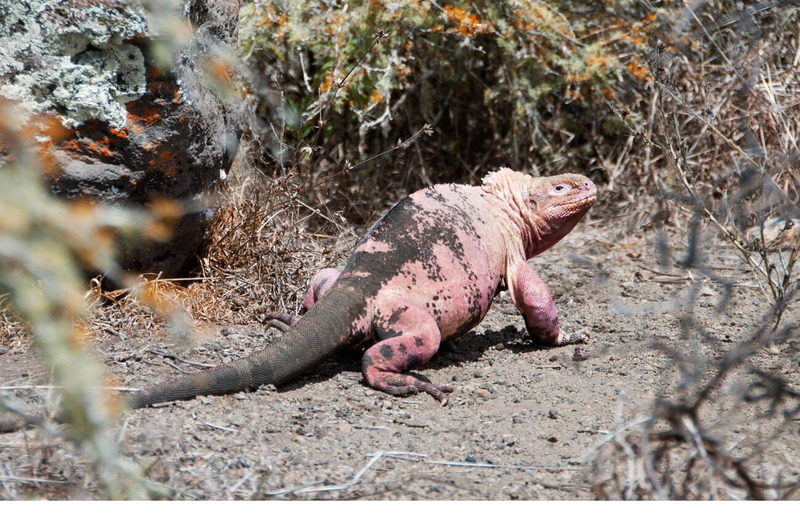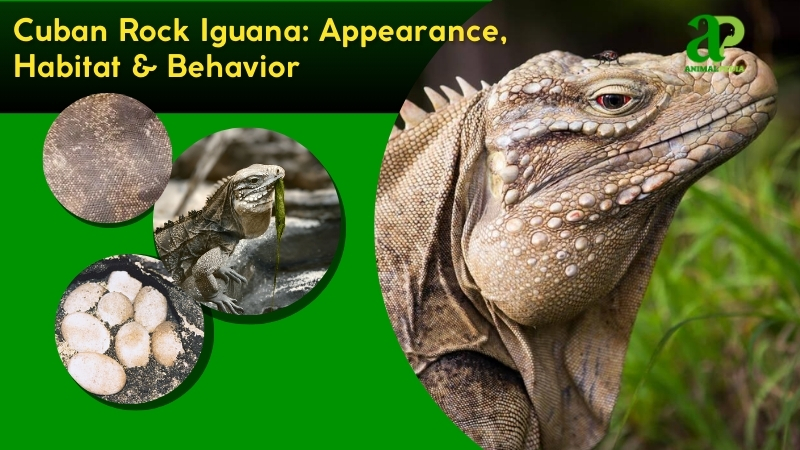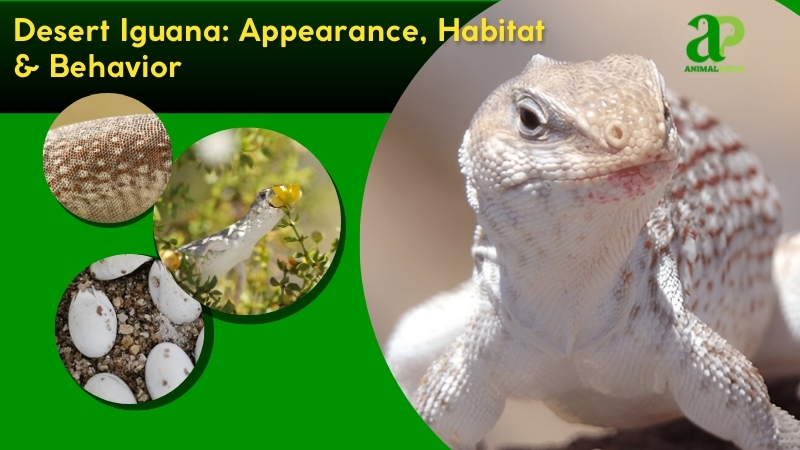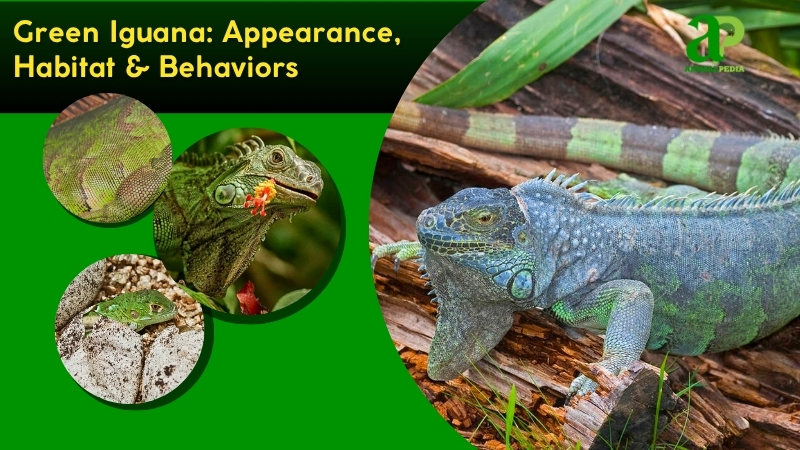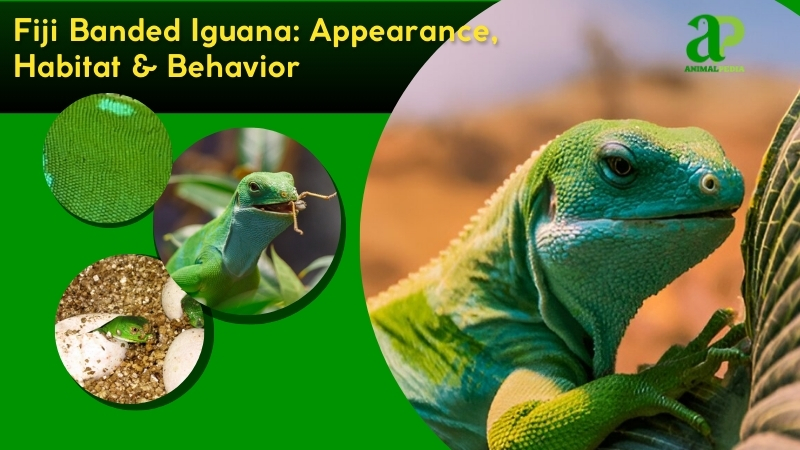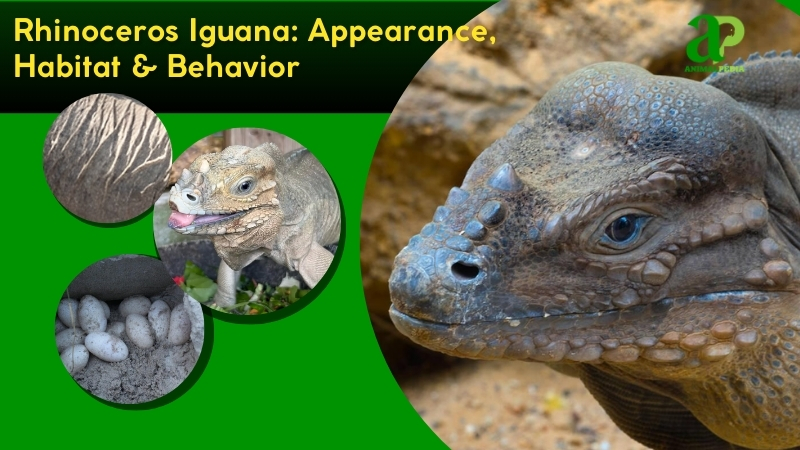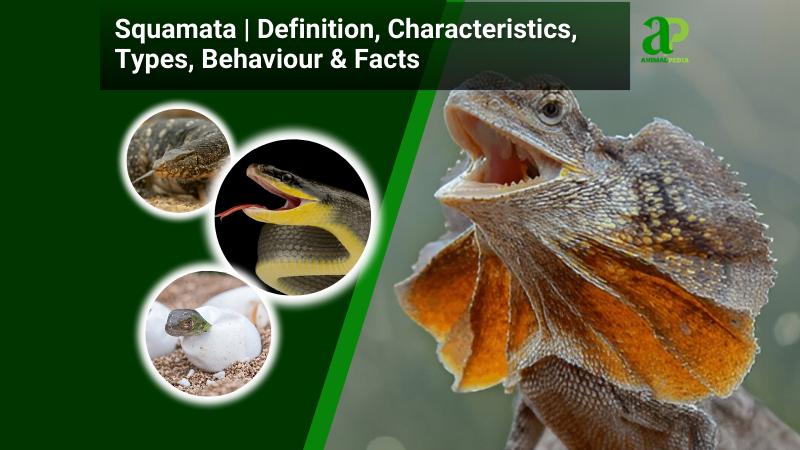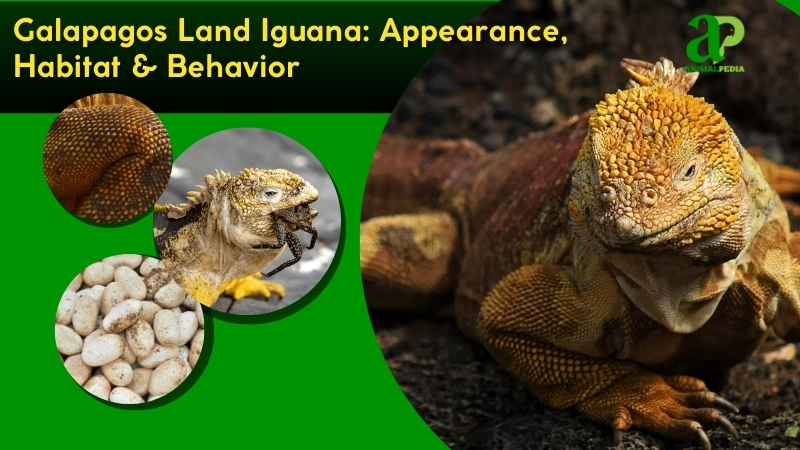The Galapagos Pink Land Iguana, scientifically known as Conolophus marthae and commonly referred to as the Rosada Land Iguana or Galapagos Rosada Iguana, is a captivating species found exclusively on the northern slopes of Wolf Volcano on Isabela Island in the Galapagos archipelago. Standing out with its unique pink-and-striped appearance, this iguana can reach up to 3 feet in length, making it one of the largest iguanas in the Galapagos.
As apex predators in their ecosystem, these iguanas exhibit territorial behaviors and impressive hunting agility. They primarily prey on insects and centipedes, and occasionally on small birds, showcasing their dietary specialization in the unique volcanic habitat they inhabit. Despite being apex predators, human interaction poses a significant threat to their population, with habitat destruction and introduced predators affecting their survival.
During mating season, which typically occurs between December and March, female Galapagos Pink Land Iguanas venture out to lay their eggs in burrows or crevices. After a gestation period of around 90 days, the eggs hatch, and the young iguanas, known as dragonets, must fend for themselves from an early age.
It takes several years for these juvenile iguanas to reach maturity, with an average lifespan of over 60 years in the wild.
In this article, we explore the fascinating Galapagos Pink Land Iguana, focusing on its distinctive features, habitat preferences, and behavioral adaptations that enable it to survive in Jamaica’s ecosystems.
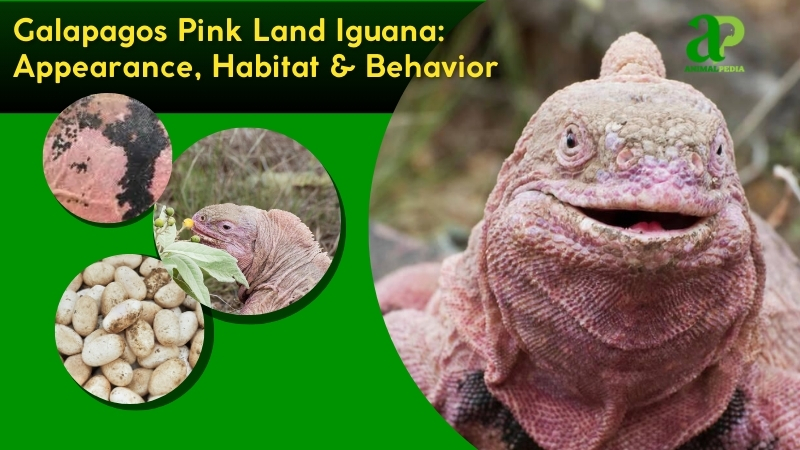
What do the Galapagos Pink Land Iguanas look like?
The Galápagos Pink Land Iguana has a robust, squat, quadrupedal body, typical of iguanids. Its overall color is a striking pale pink with scattered black vertical stripes or spots, distinguishing it from other iguanas. The skin is rough and scaly, covered in small, overlapping scales, with a row of short dorsal spines running from the neck to the tail, giving it a rugged texture. This critically endangered species, found only on Wolf Volcano, Isabela Island, exhibits a unique lack of pigmentation, revealing blood beneath the skin that gives it its rosy hue.
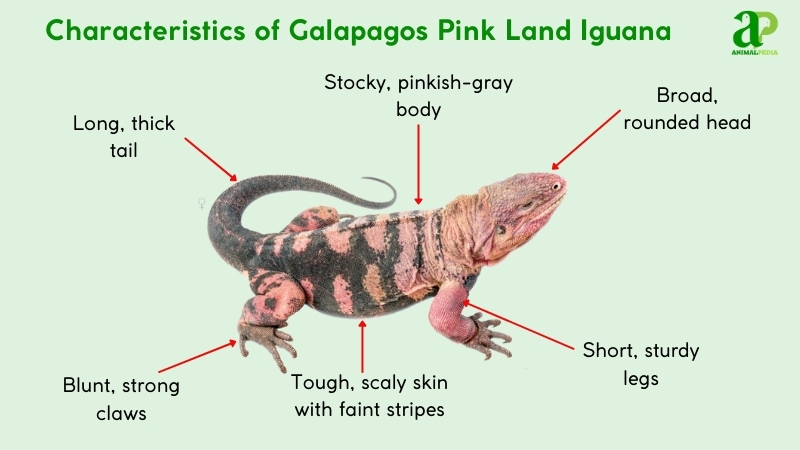
The head is short and broad, with small, dark eyes offering keen vision. Its tongue, though not well documented, likely helps it sense its environment, as is typical of lizards. The neck is thick, adorned with small nuchal spines, leading to a stocky body. Limbs are muscular, with sprawling legs that end in sharp, curved claws for digging and climbing. The tail, elongated at 24.2 in (61.4 cm) in the holotype, is thick and tapers, aiding balance.
The Pink Iguana’s ancient genetic divergence (5.7 million years) marks it as a truly unique lineage, even from its yellowish relative, Conolophus subcristatus. This story of a critically endangered reptile evolving in isolation is a theme repeated on other islands, most famously with the Jamaican Iguana species in the Caribbean.
How big do Galapagos Pink Land Iguanas get?
The Galápagos pink land iguana (Conolophus marthae) has an average height of about 1 foot (0.3 meters) at the shoulder and weighs approximately 20-25 pounds (9-11 kilograms). The longest and heaviest recorded specimen measured around 4 feet (1.2 meters) in length and weighed an estimated 75 pounds (34 kilograms), discovered on Wolf Volcano, Isabela Island, as documented in Gentile and Snell’s 2009 research establishing it as a distinct species. Adult pink land iguanas typically reach 3-4 feet (0.9-1.2 meters) in length from snout to tail, with width varying minimally due to their robust, cylindrical bodies.
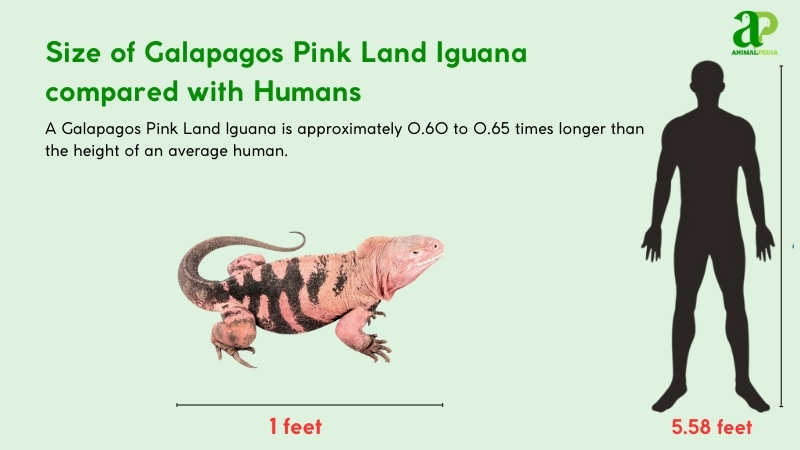
Males are generally longer and heavier than females, averaging 3.5-4 feet (1.1-1.2 meters) and 25-30 pounds (11-14 kilograms), while females range from 3-3.5 feet (0.9-1.1 meters) and 20-25 pounds (9-11 kilograms). This sexual dimorphism reflects males’ larger crests and territorial behavior.
| Trait | Male | Female |
| Length (ft) | 3.5-4 (1.1-1.2 m) | 3-3.5 (0.9-1.1 m) |
| Weight (lb) | 25-30 (11-14 kg) | 20-25 (9-11 kg) |
What are the unique physical characteristics of the Galapagos Pink Land Iguana?
The Galápagos pink land iguana (Conolophus marthae) exhibits a unique pink coloration with black striping, a trait exclusive among iguana species that distinguishes it from the green or gray tones of relatives like Conolophus subcristatus. This vivid hue, paired with prominent dorsal spines, reflects its adaptation to the isolated Wolf Volcano on Isabela Island, a volcanic environment that has shaped its distinct evolutionary path. No other iguana species displays this pink-black pattern, making it a striking example of Galápagos endemism.
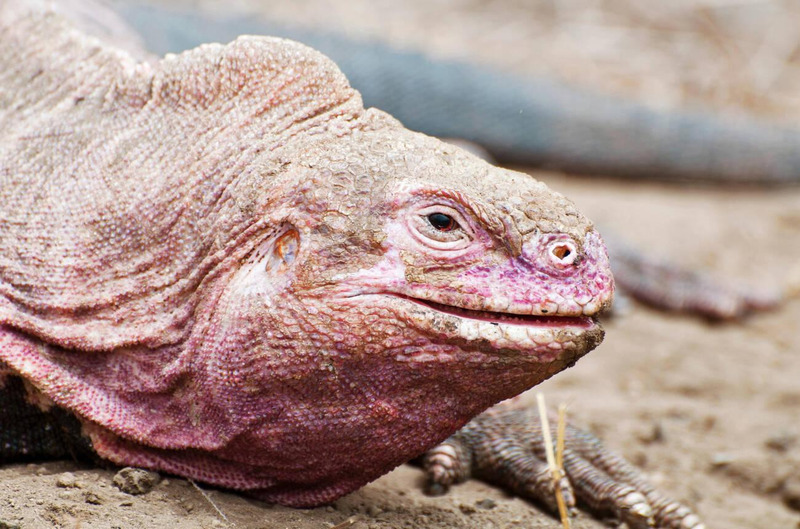
Recent research highlights the pink coloration’s basis in reduced green pigmentation and elevated erythrophore (red pigment cell) density in its skin, as noted in a 2022 health assessment study. This work, conducted on Wolf Volcano, suggests the trait is genetically fixed, stable across generations, and possibly linked to mate signaling or camouflage against lava rocks.
A 2024 study further identified a novel herpesvirus in the species, raising conservation concerns, though no health impacts were observed, suggesting potential coevolutionary adaptation. These findings underscore its critical endangerment and unique biology.
How do Galapagos Pink Land Iguanas adapt to their unique features?
The Galápagos pink land iguana leverages its unique pink coloration with black striping to survive on Wolf Volcano’s harsh volcanic terrain. This pigmentation aids camouflage against lava rocks, reducing predation risk from hawks, while the pink hue may enhance mate attraction in its isolated habitat, as noted in a 2022 study (Colosimo et al., 2022). These adaptations are critical for its survival in a food-scarce, arid environment.
Supporting this, its senses bolster environmental adaptation. Keen eyesight detects predators and prey across rocky expanses. Acute hearing alerts it to distant threats or mates. A keen sense of smell helps locate sparse vegetation for sustenance. Robust tactile sensitivity enables efficient navigation over uneven volcanic surfaces.
Anatomy
The Galápagos Pink Land Iguana, a resilient classification of reptile endemic to Wolf Volcano, Isabela Island, boasts specialized physiological systems adapted to its volcanic, arid environment:
- Respiratory System: Possesses efficient lungs with air flowing through nostrils to the trachea and alveoli, oxygenating blood to sustain its pink-and-black coloration during basking and foraging.
- Circulatory System: Features a three-chambered heart (two atria, one ventricle) with partial septation, delivering oxygen to muscles for navigating rocky terrain and supporting its robust build.
- Digestive System: Equipped with a large stomach and elongated intestines, it processes sparse, tough vegetation like cacti, aided by powerful jaws for grinding.
- Excretory System: Paired kidneys excrete uric acid through the cloaca, optimizing water conservation in a dry habitat reliant on minimal plant moisture.
- Nervous System: Includes a well-developed brain and spinal cord, with keen eyes detecting threats 5–10 meters (16–33 feet) away and a forked tongue sensing chemical cues for survival.
These systems collectively enable the pink land iguana to thrive in its harsh, isolated wild.
Where do Galapagos Pink Land Iguanas live?
The Galápagos pink land iguana is distributed solely on Wolf Volcano, northern Isabela Island, Galápagos Archipelago, Ecuador, with its population concentrated within a 25 km² area near the volcano’s rim and slopes. This critically endangered species is not found elsewhere, highlighting its extreme endemism.
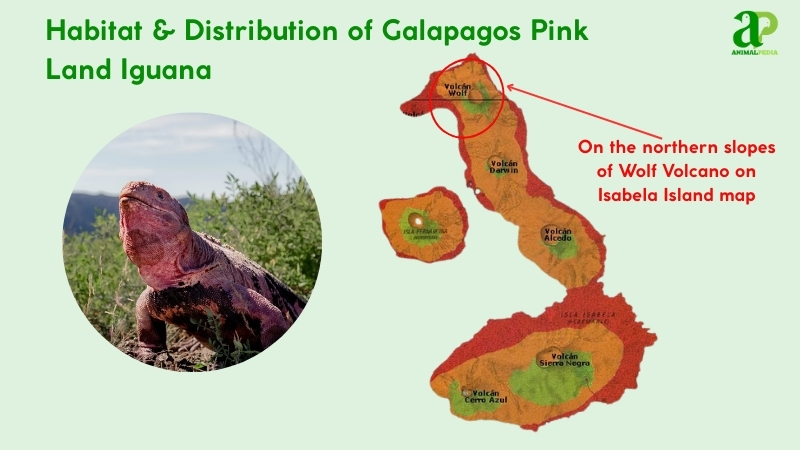
The living environment features arid, volcanic terrain with sparse vegetation, such as cacti and shrubs, which are ideal for this iguana due to its ability to conserve water and digest tough plants. The rocky, lava-strewn landscape supports its camouflage and basking needs. Research from 2022 (Colosimo et al.) indicates that these iguanas have inhabited this locale for millennia, with no evidence of migration; their isolation is driven by geographic barriers and genetic divergence from a founder population, as per phylogenetic studies.
How do seasonal changes affect their behavior?
The Galápagos pink land iguana (Conolophus marthae) adapts its behavior to the Galápagos’ wet (December–May) and dry (June–November) seasons on Wolf Volcano, enhancing survival in its arid, volcanic habitat. These adjustments optimize resource use in a challenging subtropical climate.
Males display territoriality year-round, intensifying in the wet season with head-bobbing to attract mates. In the wet season, they forage 30–50 meters daily for cacti and shrubs, reducing to 15–30 meters in the dry season. Breeding peaks in the wet season, with females laying eggs in shallow burrows that hatch by late wet or early dry months.
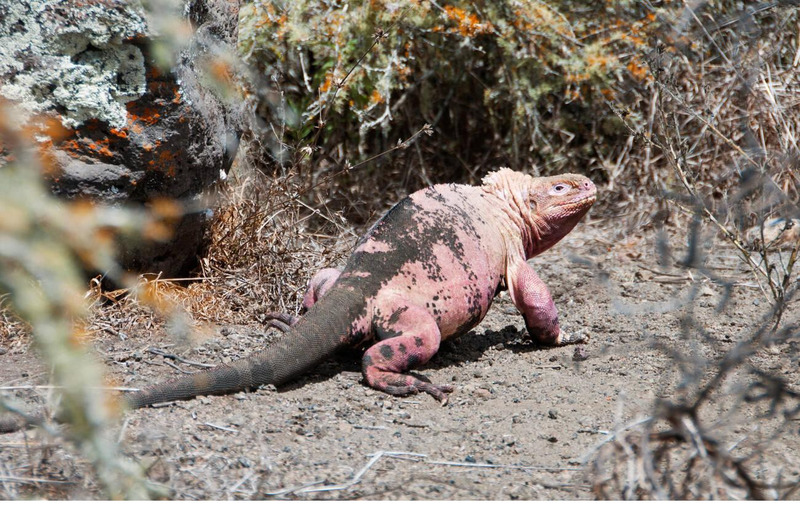
- Wet Season (December–May)
Activity rises, spanning 20–30 m² as sparse vegetation grows in 75–85% humidity and 26–30°C (79–86°F). Basking lasts 1–2 hours, aided by occasional rain.
- Dry Season (June–November)
Movement drops 25–35%, conserving energy as food scarcity increases. Basking lasts 3–4 hours at 24–28°C (75–82°F), with maximum heat at 50–65% humidity.
What is the behavior of the Galapagos Pink Land Iguana?
The Galapagos Pink Land Iguana has distinct traits and behaviors as follows:
- Diet: Strictly herbivorous, feeding on cacti, shrubs, leaves, fruits, and flowers with seasonal and age-related variations.
- Hunting Mechanisms: Forages leisurely for plants, using strong jaws and flat teeth to grind tough plant material.
- Daily Activity Patterns: Diurnal, most active in the early morning and late afternoon, basking and foraging.
- Locomotion Capabilities: Moves with a slow, deliberate gait on land; not suited for water.
Social Structure: Primarily solitary but may form small groups during breeding or when food is abundant. - Communication: Uses body language, including head-bobbing and tail flicking, to signal territory or emotions.
What do Galapagos Pink Land Iguanas eat?
The Galápagos pink land iguana is strictly herbivorous, thriving on Wolf Volcano’s sparse vegetation, including cacti, shrubs, and leaves. It employs strong jaws and flat teeth to grind tough, fibrous plant matter, an adaptation to its arid, volcanic habitat, where food is scarce.
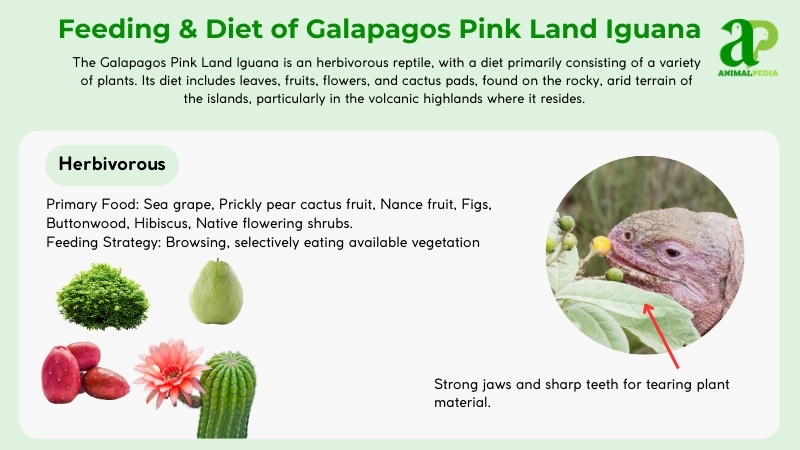
Diet by Age
Diet evolves with age to meet nutritional needs. Hatchlings (0–1 year) eat soft leaves and occasional flowers near nesting sites for early development. Juveniles (1–3 years) consume tougher cacti and shrubs, foraging 10–30 meters daily to build resilience. Subadults (3–8 years) target denser vegetation, expanding their growth range. Adults (8+ years) favor cacti pads and thick leaves, with males securing optimal feeding zones.
Diet by Gender
Males and females share identical diets, using biting and grinding without chewing adaptations.
Diet by Seasons
As opportunistic feeders, they adapt seasonally. In the wet season (December–May), they prioritize rare fruits and softer plants; in the dry season (June–November), they rely on hardy cacti and leaves to endure scarcity.
How do Galapagos Pink Land Iguanas hunt their prey?
As herbivores, Galapagos Pink Land Iguanas don’t actively hunt for prey. Instead, they leisurely roam their habitats in search of vegetation to eat. These unique creatures spend their days basking in the sun and grazing on plants, fruits, flowers, and cactus pads.
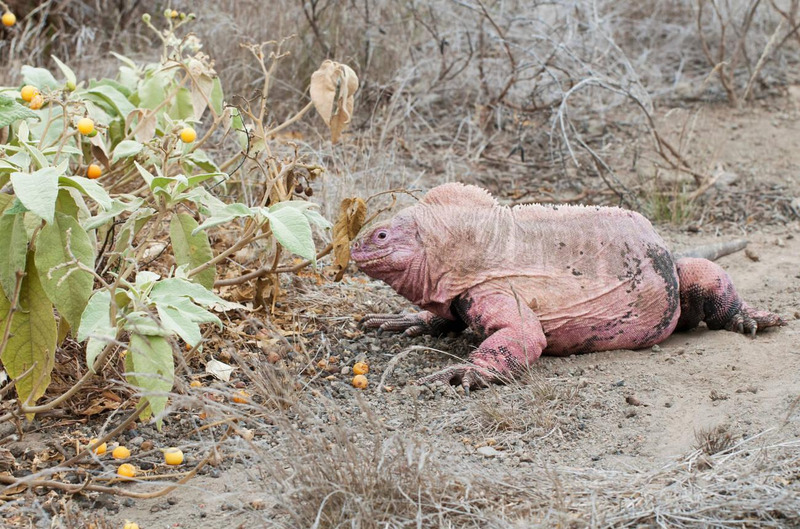
Unlike predators, they don’t stalk or chase their food; rather, they peacefully graze on plants in their environment.
Are Galapagos Pink Land Iguanas venomous?
Galapagos Pink Land Iguanas don’t possess venom. Instead of relying on venom to hunt, these iguanas use their agility and keen senses. Their striking pink bodies with dark stripes serve as camouflage in their habitat. These gentle herbivores primarily feed on cacti, fruits, and flowers, showcasing their peaceful nature.
Galapagos Pink Land Iguanas exhibit fascinating behaviors, such as regulating body temperature by basking in the sun and engaging in territorial displays. Often found in groups, they enjoy sunning themselves or leisurely exploring their surroundings.
Despite their intimidating look, these iguanas move slowly and purposefully across rocky terrain. Witnessing their calm demeanor and unique appearance can be a captivating experience for those fortunate enough to encounter them in the wild. Without venomous capabilities, these majestic creatures offer a safe and mesmerizing encounter for nature enthusiasts.
When are Galapagos Pink Land Iguanas most active during the day?
Galapagos Pink Land Iguanas are most active in the early morning and late afternoon, enjoying sunbathing to warm up. During these times, they search for food such as fruits, flowers, and leaves, demonstrating their resourcefulness.
In the late afternoon, they may interact with other iguanas, displaying high energy levels. You can spot these distinctive pink iguanas gracefully moving across rocky terrain during their active periods.
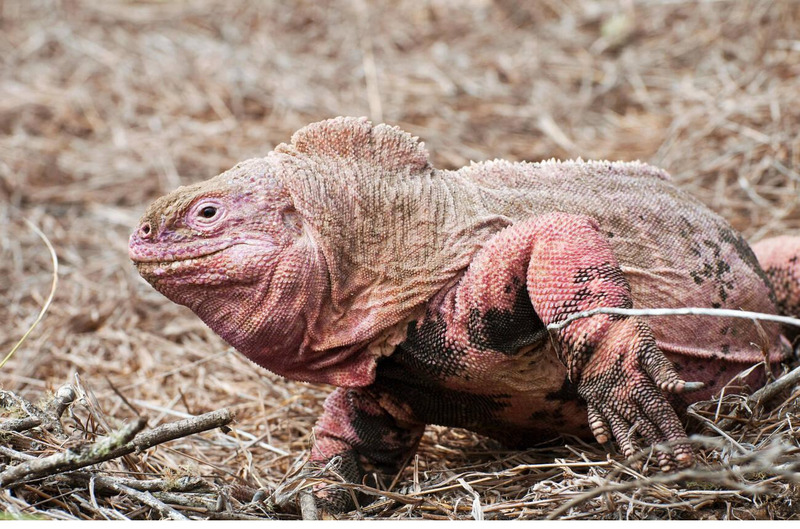
Their curiosity and vigor showcase their love for exploring their habitat. Keep watch during these times to witness these stunning creatures in action, embracing the natural world with grace and beauty.
How do Galapagos Pink Land Iguanas move on land and water?
Galapagos Pink Land Iguanas move on land with a slow and deliberate gait. These intriguing creatures gracefully navigate their terrestrial environment with a distinctive swagger. With their compact bodies and long tails, they move methodically, resembling ancient reptilian dancers as they explore the rugged terrain of the Galapagos Islands, showcasing their unique lizard-like agility.
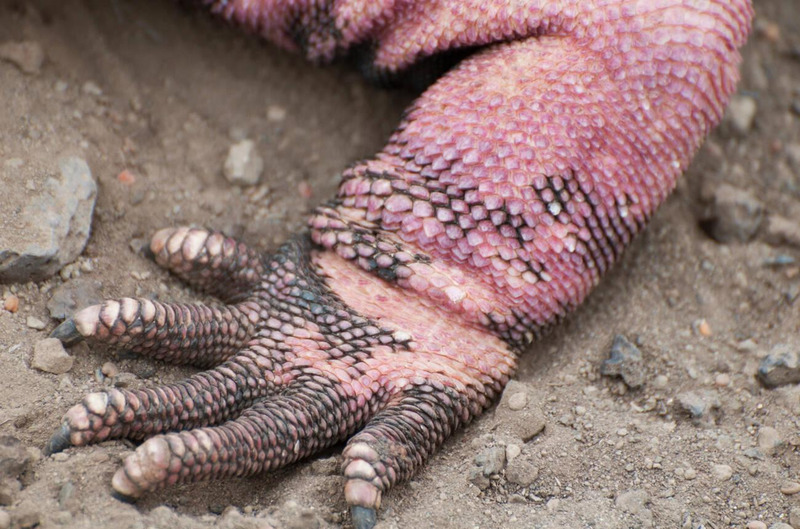
While they excel on land, Galapagos Pink Land Iguanas aren’t built for water. They avoid aquatic environments and rarely venture near the coast. Their true talent lies in maneuvering through the volcanic landscapes and rocky outcrops that define their island habitat. Observing them traverse the land is akin to witnessing a living fossil in motion, highlighting their adaptation to the challenging terrain they call home. These creatures truly embody freedom in their movements on solid ground.
Do Galapagos Pink Land Iguanas live alone or in groups?
Galapagos Pink Land Iguanas exhibit diverse social behaviors that vary with the season and breeding status. They can often be seen basking alone in the sun or gathering in small groups during specific times. Male iguanas may engage in territorial displays during the breeding season to attract females and establish dominance. While they typically prefer solitude, iguanas can interact, especially when food is abundant. They may share basking spots or engage in gentle interactions.
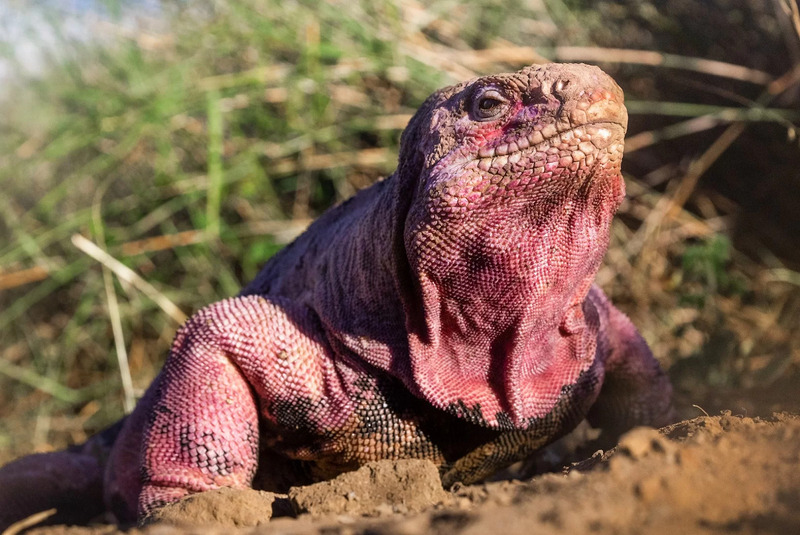
Although they occasionally gather socially, Galapagos Pink Land Iguanas generally enjoy solitude in their daily activities. They’re commonly observed exploring their rocky habitats independently, searching for juicy cacti to consume. Each iguana has its own territory to roam and defend against intruders.
Whether sharing moments with others or enjoying solitude, these iguanas exhibit a fascinating balance of social behaviors that make them captivating creatures to observe.
How do Galapagos Pink Land Iguanas communicate with each other?
Galapagos Pink Land Iguanas communicate mainly through visual displays and body language. These intriguing creatures use a variety of movements and gestures to convey messages to one another. When two iguanas meet, they often engage in head-bobbing displays, which can signal territorial warnings or courtship intentions.
Tail flicking is another common form of communication used to express emotions like agitation or distress. In group settings, these iguanas participate in complex interactions involving intricate body postures to establish social hierarchies within their community.
Their striking pink bodies and distinctive dark stripes play a crucial role in facilitating these visual displays, aiding communication. Through these visual cues and behaviors, Galapagos Pink Land Iguanas effectively interact and convey messages within their social circles.
How do Galapagos Pink Land Iguanas reproduce?
The Galápagos pink land iguana (Conolophus marthae) reproduces oviparously, with females laying eggs after mating. Breeding season specifics are unclear due to limited data, but it likely begins around June, aligning with related species like C. subcristatus. During this period, males perform rapid head-bobbing (three times in 4-5 seconds) to attract females, a unique flirtation trait. Females respond subtly, and interactions involve males approaching with displays, though detailed courtship is understudied.
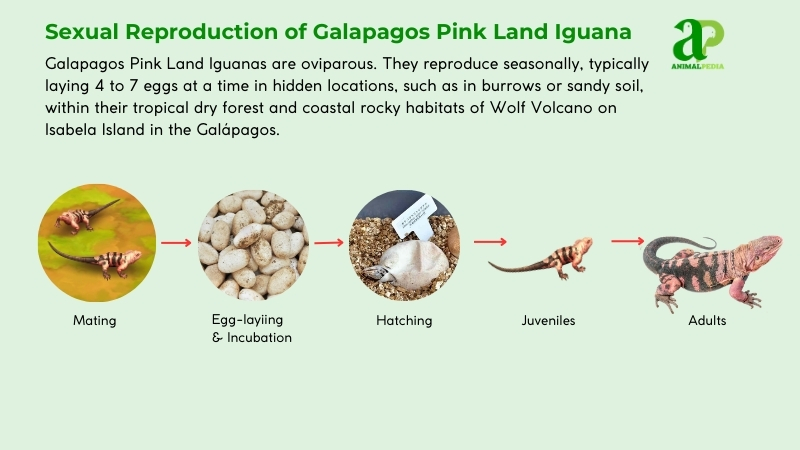
Post-mating, females lay approximately 10-15 eggs, each weighing about 80-100 grams, based on iguana norms and limited observations. Eggs are buried in shallow nests on Wolf Volcano’s volcanic soil, unprotected beyond initial digging, with no parental guarding noted. Males and females then resume solitary foraging. Egg-laying interruptions, possibly due to volcanic activity (e.g., the 2015 eruption), lack specific documentation but could disrupt nesting.
Incubation lasts 90-120 days, with hatchlings emerging yellowish-green, growing slowly over the years, reaching maturity at 8-15 years. Predation by feral cats and rats threatens juveniles, with few surviving to adulthood. The life cycle spans 50-60 years, though population estimates (200-300 adults) and rare juvenile sightings suggest low recruitment. Research from 2024 (Nieto-Claudín et al.) identified a novel herpesvirus that may impact health, while conservation efforts, including proposed captive breeding, aim to bolster this critically endangered species’ survival on its isolated volcanic home.
How long do Galapagos Pink Land Iguanas live?
The Galápagos pink land iguana (Conolophus marthae) has a life cycle spanning 50-60 years, from egg to death, with maturity reached at 8-15 years. Notes include its critically endangered status, with a population of 200-300 adults, and threats such as predation on juveniles by feral species, which reduce recruitment rates.
The average lifespan in the wild is approximately 50 years, based on related iguana species and limited observations. Male and female lifespans appear similar, though no sex-specific data exists due to the species’ rarity and restricted study, primarily on Wolf Volcano. Conservation efforts are critical for its survival.
What are the threats or predators that Galapagos Pink Land Iguanas face today?
The Galápagos pink land iguana (Conolophus marthae), confined to Wolf Volcano, faces multiple threats: predation by invasive species, volcanic eruptions, limited distribution, small population size, lack of juvenile recruitment, and potential hybridization with C. subcristatus.
- Invasive Predation: Feral cats and rats heavily prey on eggs and hatchlings, resulting in a near-total absence of juveniles since 2014 and critically threatening population renewal.
- Volcanic Eruptions: Frequent eruptions (e.g., 2022) destroy habitat and food sources, potentially wiping out significant numbers of the 200-300 adults in a single event.
- Limited Distribution: Restricted to 25 km², this makes the species highly vulnerable to localized disasters, amplifying extinction risk.
- Small Population: With only 200-300 individuals, genetic diversity is low, increasing susceptibility to disease and stochastic events.
- Lack of Recruitment: Predation and habitat issues result in no juvenile survival, stalling population growth, and risking collapse.
- Hybridization: Rare mating with C. subcristatus dilutes genetic integrity, potentially reducing adaptive traits unique to C. marthae.
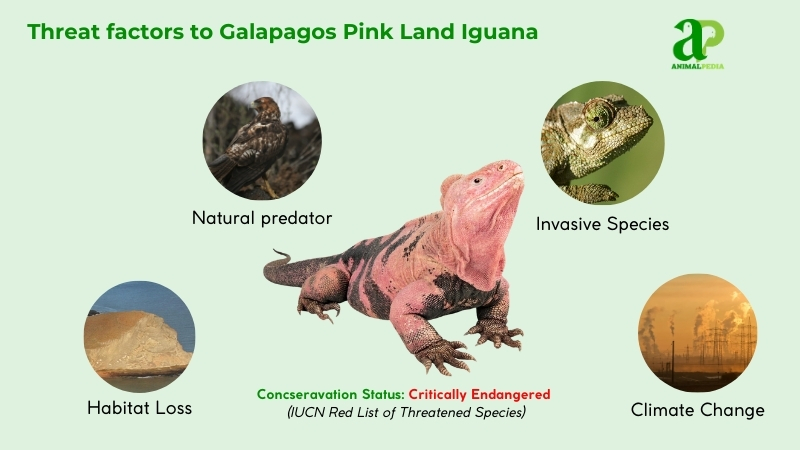
Predators include feral cats (targeting hatchlings and juveniles), black rats (eating eggs and nibbling adults), and the native Galápagos hawk (Buteo galapagoensis), which preys on young iguanas.
Human impact stems from introducing invasive species like cats and rats, devastating juvenile survival and habitat. Tourism and historical settlement indirectly exacerbate habitat pressure, though direct exploitation is absent. Research from Colosimo et al. (2022) documents predation’s toll via health assessments, showing no juveniles in surveys, while Nieto-Claudín et al. (2024) note a novel herpesvirus, possibly linked to stress from human-altered ecosystems, though its impact is unclear. Conservation efforts, including predator control, are urgent to mitigate these human-induced threats.
Are Galapagos Pink Land Iguanas endangered?
Yes, the Galápagos pink land iguana (Conolophus marthae) is endangered. Its extreme rarity, restricted range, and ongoing threats confirm its precarious status, as recognized by conservation bodies and recent studies.
The species is classified as Critically Endangered on the IUCN Red List, the highest threat category before extinction in the wild. This designation reflects its limited distribution (25 km² on Wolf Volcano, Isabela Island), small population, and severe pressures from invasive predators and habitat disruption. The IUCN’s assessment underscores its vulnerability to stochastic events and lack of juvenile recruitment, aligning with field observations since its discovery in 2009.
Current population estimates peg the number of mature individuals at 200-300, with no significant juvenile presence noted since 2014. Research by Colosimo et al. (2022) conducted health assessments on Wolf Volcano, finding a census of approximately 211 adults in 2020, with no hatchlings or juveniles observed, signaling a recruitment crisis. Supporting this, Nieto-Claudín et al. (2024) report a stable but tiny adult population, further constrained by predation and a novel herpesvirus, though its demographic impact is under study. These figures highlight the species’ dire straits, and conservation interventions such as predator eradication are being explored to bolster its numbers.
What conservation efforts are underway?
Conservation efforts for the Galápagos pink land iguana (Conolophus marthae) are spearheaded by the Galápagos National Park Directorate (GNPD) and Galápagos Conservancy under the 2022-2027 Pink Iguana Conservation and Management Plan. This initiative, launched in 2022, focuses on monitoring population, controlling invasive species, and filling ecological knowledge gaps, with a three-year initial phase (2022-2024) targeting natural recruitment. Key organizations also include the Charles Darwin Foundation, which supports research such as the 2024 herpesvirus study.
Specific laws under Ecuadorian legislation protect the species within the Galápagos National Park, established in 1959. These prohibit hunting, habitat disturbance, and introduction of non-native species, with strict access restrictions to Wolf Volcano—allowing only scientific and conservation personnel since 2009—to minimize human impact.
Breeding programs are in early stages, with a head-start initiative proposed by the GNPD and Galápagos Conservancy. Following the 2022 discovery of hatchlings—the first in over a decade—plans for captive breeding intensified. A pilot phase, starting with 2-3 males, tests adaptability to sea-level captivity and aims to release offspring back to Wolf Volcano if invasive species are managed by 2025. Success data is limited, but the 2022 nesting site identification marks a breakthrough, revealing predation challenges with camera traps. Historical success with C. subcristatus—over 700 iguanas reintroduced since 1980—offers a model, though C. Marthae’s unique needs require cautious scaling.
Notable successes include the 2019 reintroduction of C. subcristatus to Santiago Island, restoring ecological balance after 200 years, a feat the GNPD now seeks to replicate for C. marthae. Ongoing expeditions, like the 2024 Wolf Volcano survey, reinforce hope, despite no juveniles being observed, driving urgency for intensified predator control and breeding efforts to secure this critically endangered species’ future.
Frequently Asked Questions
Why Are Galapagos Pink Land Iguanas Pink in Color?
You should know that Galápagos pink land iguanas are pink because of their distinctive pinkish bodies with dark stripes. This unique coloration, resembling a pink iguana, sets them apart from other land iguana species.
Do Galapagos Pink Land Iguanas Have Any Unique Behaviors?
When facing the question of the unique behaviors of Galapagos pink land iguanas, you’ll be pleased to learn about their distinctive head-nodding displays. These displays are not only complex but also unique among land iguana species.
How Long Do Galapagos Pink Land Iguanas Live in the Wild?
In the wild, Galapagos pink land iguanas can live up to 60 years. These fascinating creatures thrive in their natural habitat for several decades, gracing the Galapagos Islands with their unique presence and longevity.
Are There Any Specific Adaptations That Galapagos Pink Land Iguanas Have?
Yes, Galapagos Pink Land Iguanas have specific adaptations. Some unique traits include their pink bodies with dark stripes, complex territorial displays, and anatomical differences from other land iguana species. These adaptations help them thrive in their habitat.
How Do Researchers Study and Monitor the Population Numbers of Galapagos Pink Land Iguanas?
To study and track Galapagos pink land iguana populations, researchers use methods such as field surveys, individual tagging, and genetic analysis. These efforts help monitor population numbers, movement patterns, and genetic diversity for conservation purposes.
Conclusion
To summarize, the Galapagos Pink Land Iguana is an intriguing reptile with a distinctive presence, flourishing in the volcanic landscape of Isabela Island. Their pink-hued bodies, territorial tendencies, and plant-based diet make them a truly enchanting species to study. Despite challenges from invasive predators, these iguanas persist in their native environment, demonstrating the resilience of nature. Keep delving into the marvels of the Galapagos Pink Land Iguana and value the splendor of our planet’s biodiversity!

